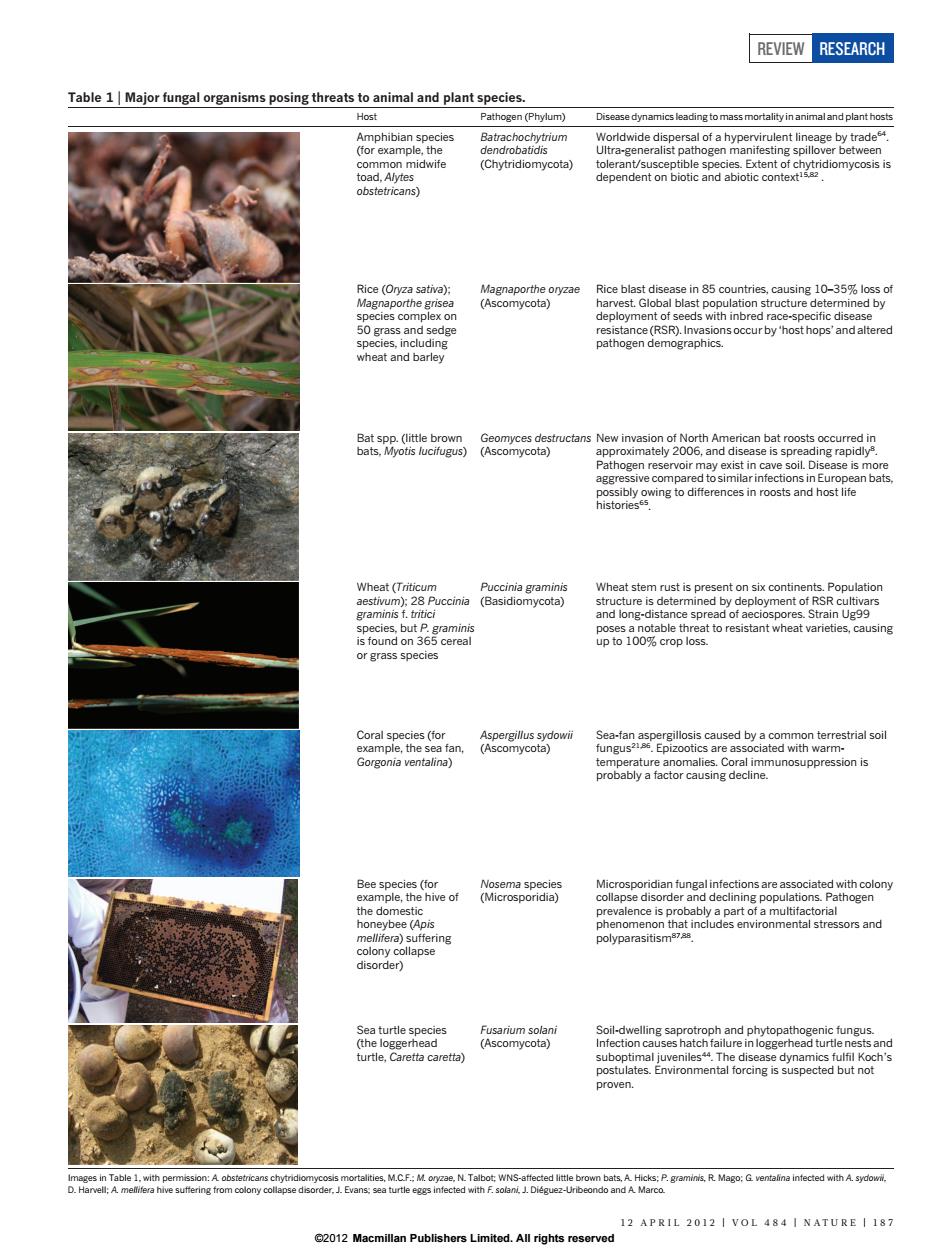正在加载图片...

REVIEW RESEARCH Table 1|Major fungal organisms posing threats to animal and plant species. Host Pathogen(Phylum) Disease dynamics leading to mass mortality in animal and plant hosts Amphibian species Batrachochytrium Worldwide dispersal of a hypervirulent lineage by trade (for example,the dendrobatidis Ultra-generalist pathogen manifesting spillover between common midwife (Chytridiomycota) tolerant/susceptible species.Extent of chytridiomycosis is toad,Alytes dependent on biotic and abiotic context obstetricans) Rice (Oryza sativa): Magnaporthe oryzae Rice blast disease in 85 countries,causing 10-35%loss of Magnaporthe grisea (Ascomycota) harvest.Global blast population structure determined by species complex on deployment of seeds with inbred race-specific disease 50 grass and sedge resistance(RSR).Invasions occur by 'host hops'and altered species,including pathogen demographics. wheat and barley Bat spp.(little brown Geomyces destructans New invasion of North American bat roosts occurred in bats.Myotis lucifugus) (Ascomycota) approximately 2006,and disease is spreading rapidly Pathogen reservoir may exist in cave soil.Disease is more aggressive compared to similar infections in European bats, possibly owing to differences in roosts and host life historiesss Wheat(Triticum Puccinia graminis Wheat stem rust is present on six continents.Population aestivum):28 Puccinia (Basidiomycota) structure is determined by deployment of RSR cultivars graminis f.tritici and long-distance spread of aeciospores.Strain Ug99 species,but P.graminis poses a notable threat to resistant wheat varieties,causing is found on 365 cereal up to 100%crop loss. or grass species Coral species(for Aspergillus sydowii Sea-fan aspergillosis caused by a common terrestrial soil example,the sea fan, (Ascomycota)) fungus2186.Epizootics are associated with warm- Gorgonia ventalina) temperature anomalies.Coral immunosuppression is probably a factor causing decline. Bee species(for Nosema species Microsporidian fungal infections are associated with colony example,the hive of (Microsporidia) collapse disorder and declining populations.Pathogen the domestic prevalence is probably a part of a multifactorial honeybee (Apis phenomenon that includes environmental stressors and mellifera)suffering polyparasitism7a colony collapse disorder) Sea turtle species Fusarium solani Soil-dwelling saprotroph and phytopathogenic fungus. (the loggerhead (Ascomycota) Infection causes hatch failure in loggerhead turtle nests and turtle,Carettacaretta) suboptimal juveniles44.The disease dynamics fulfil Koch's postulates.Environmental forcing is suspected but not proven. Images in Table 1.with permission:A obstetricans chytridiomycosis mortalities,M.C.F.:M.oryzae,N.Talbot:WNS-affected little brown bats,A Hicks;P.graminis,R.Mago:G ventalina infected with A.sydowil. D.Harvell:A melifera hive suftering from colony collapse disorder.J.Evans:sea turtle eggs infected with F.solani.J.Dieguez-Uribeondo and A Marco. 12 APRIL 2012 VOL 484 I NATURE 187 2012 Macmillan Publishers Limited.All rights reservedTable 1 | Major fungal organisms posing threats to animal and plant species. Host Pathogen (Phylum) Disease dynamics leading to mass mortality in animal and plant hosts Amphibian species (for example, the common midwife toad, Alytes obstetricans) Batrachochytrium dendrobatidis (Chytridiomycota) Worldwide dispersal of a hypervirulent lineage by trade64. Ultra-generalist pathogen manifesting spillover between tolerant/susceptible species. Extent of chytridiomycosis is dependent on biotic and abiotic context15,82 . Rice (Oryza sativa); Magnaporthe grisea species complex on 50 grass and sedge species, including wheat and barley Magnaporthe oryzae (Ascomycota) Rice blast disease in 85 countries, causing 10–35% loss of harvest. Global blast population structure determined by deployment of seeds with inbred race-specific disease resistance (RSR). Invasions occur by ‘host hops’ and altered pathogen demographics. Bat spp. (little brown bats, Myotis lucifugus) Geomyces destructans (Ascomycota) New invasion of North American bat roosts occurred in approximately 2006, and disease is spreading rapidly8 . Pathogen reservoir may exist in cave soil. Disease is more aggressive compared to similar infections in European bats, possibly owing to differences in roosts and host life histories65. Wheat (Triticum aestivum); 28 Puccinia graminis f. tritici species, but P. graminis is found on 365 cereal or grass species Puccinia graminis (Basidiomycota) Wheat stem rust is present on six continents. Population structure is determined by deployment of RSR cultivars and long-distance spread of aeciospores. Strain Ug99 poses a notable threat to resistant wheat varieties, causing up to 100% crop loss. Coral species (for example, the sea fan, Gorgonia ventalina) Aspergillus sydowii (Ascomycota) Sea-fan aspergillosis caused by a common terrestrial soil fungus21,86. Epizootics are associated with warmtemperature anomalies. Coral immunosuppression is probably a factor causing decline. Bee species (for example, the hive of the domestic honeybee (Apis mellifera) suffering colony collapse disorder) Nosema species (Microsporidia) Microsporidian fungal infections are associated with colony collapse disorder and declining populations. Pathogen prevalence is probably a part of a multifactorial phenomenon that includes environmental stressors and polyparasitism87,88. Sea turtle species (the loggerhead turtle, Caretta caretta) Fusarium solani (Ascomycota) Soil-dwelling saprotroph and phytopathogenic fungus. Infection causes hatch failure in loggerhead turtle nests and suboptimal juveniles44. The disease dynamics fulfil Koch’s postulates. Environmental forcing is suspected but not proven. Images in Table 1, with permission: A. obstetricans chytridiomycosis mortalities, M.C.F.; M. oryzae, N. Talbot; WNS-affected little brown bats, A. Hicks; P. graminis, R. Mago; G. ventalina infected with A. sydowii, D. Harvell; A. mellifera hive suffering from colony collapse disorder, J. Evans; sea turtle eggs infected with F. solani, J. Die´guez-Uribeondo and A. Marco. REVIEW RESEARCH 12 APR IL 2012 | VOL 484 | NATURE | 187 ©2012 Macmillan Publishers Limited. All rights reserved